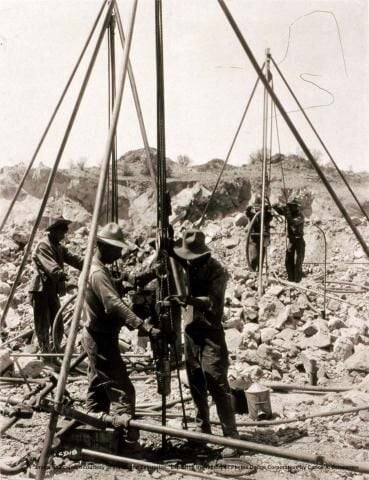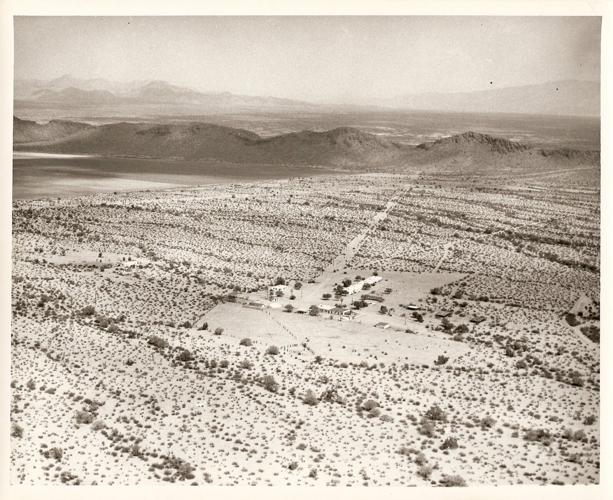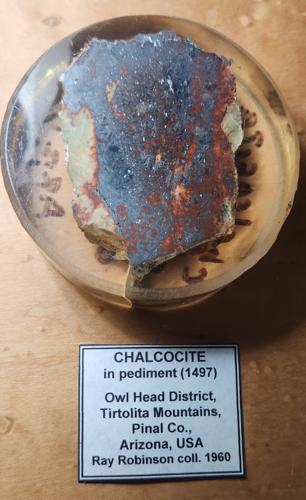The Tucson Mountains have served as a destination for mine exploration for centuries but with minimal commercial profit.
The range hosts one of the earliest mining districts in Arizona, out of 246, known as the Amole district. Early prospectors included the Hohokam tribe 1,000 years ago and later the Spanish, who explored the area in earnest for gold and silver when San Xavier Mission was founded in 1692.
Mining conducted in the 19th and 20th centuries by Mexican and Anglo miners saw limited financial success compared to improved prospects in the neighboring mountain ranges, including the Santa Catalinas and the Santa Ritas.
Transportation also proved challenging to early mining activities in Southern Arizona, with reliance on local stagecoach stops for transport and sustenance to traveling miners. Examples near Tucson included the Dragoon Stage Stop in the Dragoon Mountains, the Pantano Stage Stop near the Cienega Creek Railroad Bridge near the Rincon Mountains, and the Pointer Mountain Stage Stop in the northern Tucson Mountains.

Vanadinite from the Old Yuma Mine.
Mining in the region increased across the Tucson valley to the east in the Santa Catalina Mountains in the 1880s, where prospectors explored the area based upon gold discoveries in the Cañada del Oro, also known as the Canyon of Gold.
A major gold rush followed to capitalize on the free-flowing gold found embedded in quartz veins down the north slopes of Mt. Lemmon toward the town of Oracle. The area’s Burney Mines were named after Bob Burney, who owned a 60-ton selective flotation mill near Oracle that processed local ores, including those from the nearby Childs-Aldwinkle Mine at Copper Creek in the Santa Teresa Mountains.
This area consists of altered metasediment/porphyry breccias that include gold, lead, zinc and silver, along with areas of oxide copper mineralization. A 1980s study conducted by Cambior Exploration Inc. noted low-grade silver mineralization at .5 to 1 ounce per ton.
Collapsed volcano
Geology of the Tucson Mountains includes its history as a volcanic caldera, or collapsed volcano, last active during the Laramide Orogeny 70 million years ago. Low-grade mineralized deposits formed in geologic formations such as stocks, plugs and dikes resulting from igneous intrusions (igneous rock crystallized from molten magma).

Remnants of a lime kiln just west of Sus Picnic Area in Saguaro National Park West.
More than 15 miles long, this large ash-flow caldera is overlain by mid-tertiary basaltic andesite lavas on parts including those of Sentinel Peak, also known as “A” Mountain,” and Tumamoc Hill.
Both hills served as mine sites for the Hohokam settlers, who used the talus boulders to build agricultural terraces in the surrounding area a thousand years ago.
Mexican settlers quarried the basaltic andesite and rhyolite tuff in the 19th century, using it for foundations seen today in the earliest homes built in Tucson.
Additional areas that proved somewhat profitable in commercial mining ventures in the Tucson Mountains include the Saginaw Hill area in the south, the Gould and Mile Wide Mines in the central portion and the Old Yuma Mine in the north.
The Saginaw Hill Mine, named for financial investors from Saginaw, Michigan, is located on the southwest flank of the Tucson Mountains. Geologically it is a fissure deposit in rhyolite porphyry.
Originally located by Tucson entrepreneur Sam Hughes and christened the Sam Hughes Gold Mine, it was also known among the Mexicans as “Mina del Aguila” or Mine of the Eagle. Water was supplied by a five-mile pipeline from a well near the Santa Cruz River. Small amounts of placer gold were discovered among arroyos west and south of Saginaw Hill.
The property included a small Huntington Grinding and Amalgamating mill along with a Frue Vanner concentrating table, whose concentrates were shipped to the Thomas Hughes “Adobe Mexican Smelter” near the present junction of Mission and Irvington roads.
‘Rusty gold’
The gold is described as having a coating of iron oxide; such “rusty gold” is difficult to recover through amalgamation. High zinc content proved challenging to the table concentrates, ensuring a challenging and less profitable smelting process.

Vanadinite from the Old Yuma Mine.
In 1914, renowned geologist Ira Joralemon invested in the property, developing 10 million tons of copper ore including chalcocite and chalcopyrite. The mine circulated through many owners. High-grade silica copper ore was shipped from the mine to the Hayden smelter in 1958. The tailings were mined in the late 1980s, with several shipments sent to the Arivaca Mill for gold extraction.
Some ideas to economically exploit the mineral resource included detonation of explosives onsite and having the copper leached in place afterwards. Further exploration may yield mineable resources under positive market conditions; however, encroaching development has hindered such prospects.
Additional mining operations in the Tucson Mountains included the Gould Mine south of King Canyon. The geology is made up of fragments from a lahar, or volcanic mudslide, originating from the Tucson Mountains stratovolcano. Sporadic and sensationalized production occurred from 1906 to 1954, with around 45,000 pounds of copper produced.
The nearby Mile Wide Mine was christened such by the width of the entire claim. Originally known as the King Canyon Mine, it produced 34,000 tons including copper, gold, lead, molybdenum and zinc during both World Wars.
Lava flows
Other lava flows can be found throughout the Tucson Mountains, including those exposed at Tumamoc Hill and Sentinel Peak. These flows are composed of vesicular basaltic andesite with olivine inclusions that were mined for building stone in Tucson, still found in early home and business construction.
The Old Yuma Mine was the largest metal producer in the Amole district, with recorded figures of silver, lead, copper and molybdenum, along with gold and vanadium. Located by C.C. Stephens in 1885, the Old Yuma Mine, including the Comet lode mining claims, saw major development by its owners, Tucson lawyers John H. Martin and William H. Barnes, during World War One.
Colonel Epes Randolph also operated under government subsidy, producing molybdenum and vanadium for the war-time market.

View to the northeast with the White Stallion Ranch in the foreground and Twin Peaks in the background representing the northern part of the Tucson Mountains range circa 1946.
A gravity jig mill used to concentrate wulfenite and vanadinite produced over 30,000 tons, with concentrate shipped to the El Paso smelter for further refinement.

Chalcocite in pediment from the Owl Head Mining district in the Tortolita Mountains.
Limited production continued under the Yuma Mining Co. in the 1930s through 1954. The mine also hosted a placer deposit containing significant gold values acquired through leaching and crushing of the host rock.
The mine is notable for some of the finest samples of wulfenite and vanadinite in the world.
Industrial minerals
Large-scale residential development and environmental concerns have ended mine development and production in the Tucson Mountains during recent decades, with the exception of the active Portland Cement Co. at Twin Peaks.
Industrial minerals have been the most lucrative production in the history of the Amole district. Cal-Portland’s Portland Cement Plant was the first cement plant established in Arizona, built at Rillito in 1949 at a cost of $3 million on 200 acres of land. Located 17 miles northwest of Tucson, it supplies Tucson and south Phoenix with cement acquired from the limestone deposits at Twin Peaks, also known as Picacho de Calera.
Overall mineral production estimates in the Amole district totaled 34,000 short tons of ore, including 529,000 pounds of copper, 670,000 pounds of lead, 375,000 pounds of zinc, 17 tons of molybdenum, 27,200 ounces of silver and 1,010 ounces of gold.
Efforts to preserve the ruins of the fort have been going on for almost a century.








